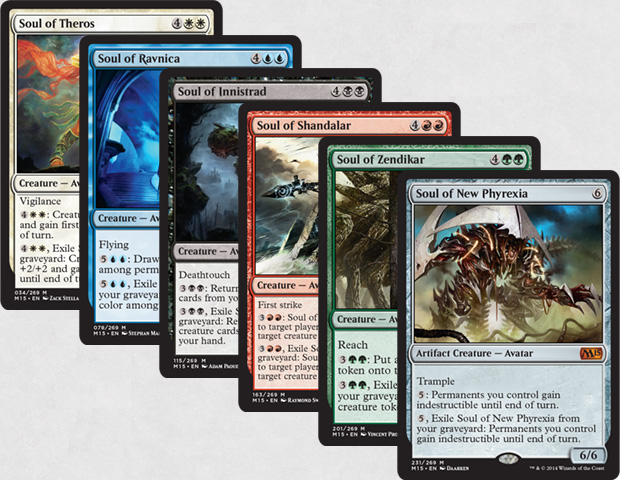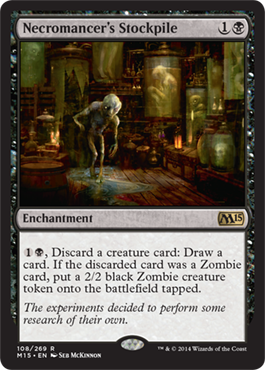Days of Core, Part 2
Welcome to the second and final Magic 2015 Preview Week. Last week, I introduced you to the design team, showed off a preview card with the returning convoke keyword and explained how the outside-designer cards came to be. But Magic 2015 has more goodies to talk about and I have another preview card, so I'm back for Part 2. If you haven't read Part 1, I suggest you give it a read, as it's kind of required reading for today's column.
You've Got to Be Duel To Be Kind
The next aspect of Magic 2015 to talk about concerns a different but related product coming out this summer, Magic 2015—Duels of the Planeswalkers. For those who have never played the popular Duels of the Planeswalkers games, it is our digital expression of Magic—on various consoles, tablets, and PC—that serves as an entry point that helps teach some of the basic principles of Magic, using AI tutorials and single-player campaigns..

One of the things we try to do each year is to create a certain amount of overlap between the core set and that year's edition of Duels of the Planeswalkers. Each year, we've gotten a bit more adventurous with how much overlap we can create between the two games. The trend did not stop for Magic 2015. This overlap was done in three ways:
- The design teams of both products worked hard to try and get as many Magic 2015 Core Set cards as possible into Magic 2015—Duels of the Planeswalkers. They weren't able to get them all in, but there's enough to ensure that this year's offeringmechanically captures the feel of this year's core set.
- Both sets were designed to cover the same campaign story. This year's game focuses on Garruk Wildspeaker's descent into darkness as the curse of the Chain Veil further takes hold, transforming Garruk from the mono-green Planeswalker everyone's come to know and love to a darker character influenced by black mana that has turned Garruk from hunting animals to hunting Planeswalkers.
- Magic 2015—Duels of the Planeswalkers requires a campaign setting that takes the player to different worlds—five different worlds, in fact: Innistrad, Ravnica, Shandalar, Theros, and Zendikar. The core set has the ability to represent multiple worlds, so the design team made sure to give glimpses to each of these five worlds.
These three overlaps played out in the design of Magic 2015 in a few different ways. Let's walk through them one by one.
Card Overlap
At first blush, this overlap might seem very easy. Most of the cards in a core set can be used in Duels of the Planeswalkers. The hard part has to do not with the cards themselves but rather the timetable of the two products. Duels of the Planeswalkers, as a digital product, just has a longer lead time than a paper set. This means, in order to include cards unique to Magic 2015, we had to work ahead and get cards done long before they were needed for the core set. This created a bunch of hurdles and limited how many cards could overlap, but both teams worked together to make sure that it could happen.
Story Overlap
Core sets have never been all that much about story. A block takes place on one particular world and tends to follow a character or series of characters and tells a specific story. Core sets, on the other hand, tend to be a hodgepodge of cards from many different worlds and, up until Duels of the Planeswalkers came along, they never tried to tell stories. But the nature of Duels of the Planeswalkers requires some type of story be told.
You see, in Duels of the Planeswalkers, you are playing the role of someone and you have to work your way through a campaign ladder that takes you to different worlds (more on this in a second) to face different opponents. The very nature of this structure begets a story. As you progress, you want to feel as if you are moving the game forward, and the easiest way to do that is through story. What this meant for R&D was that as soon as we started trying to link Duels of the Planeswalkers with the core set, we started including story elements into the core set. Magic 2015 would be no different.
The story of Magic 2015 concerns the transformation of Garruk Wildspeaker. Back in Innistrad, we witnessed Garruk get into a fight with Liliana who, along with the help of the Chain Veil, managed to not only defeat Garruk but also corrupt him. We saw this corruption in a high-profile way on a double-faced card.
Magic 2015 picks up with Garruk where Innistrad left off. The curse has continued changing Garruk, who now (as the ads point out) hunts bigger game, i.e., Planeswalkers. If you haven't had a chance to see the Duels of the Planeswalker teaser video, check it out below. As you will see, Garruk is a very different man.
To show how much he's changed, Magic 2015 has a brand-new black/green Garruk card called Garruk, Apex Predator.
In addition, the design team put in a few other cards showing off the impact of Garruk's new persona, one of which you'll see in Uncharted Realms on Wednesday.
World Overlap
Part of the campaign setting of Duels of the Planeswalker is that you travel to five different worlds as you are tracking down Garruk. As I said above, these worlds are Innistrad, Ravnica, Shandalar, Theros, and Zendikar. Shandalar, for those who might not recognize the name, is a more generic high-fantasy world we've used in previous core sets. Shandalar, for those old timers, was the setting of the first Magic computer game put out by Microprose called, simply enough, Magic: The Gathering.
The core set normally is a hodge-podge of different worlds (as opposed to a block, where the cards are all set in a single unified world) but for Magic 2015, the design team wanted to put more focus on the five worlds featured in Duels of the Planeswalkers. While this led to a lot of small choices, it also led to one high-profile mythic rare cycle, known as the Souls.

The Souls are a six-card cycle (I'll explain in a second how), where each card embodies one of the five worlds from Magic 2015—Duels of the Planeswalkers, plus an additional one. Originally, there was just going to be a five-card cycle, but the design team figured out it could also make an artifact Soul, and made it for New Phyrexia. For a while, the team was contemplating making the red soul the Soul of Tarkir, the setting of the next block, but it was decided instead to use it to represent Shandalar. The souls are all six-mana 6/6 Avatars that have a creature keyword, an activated ability, and a second activated ability that can be used once out of your graveyard (the creature exiles itself to use it).
The integration with Magic 2015—Duels of the Planeswalkers had a huge impact on the design of Magic 2015 Core Set. When you play both games, I hope you will appreciate the effort that went into making them share the same story and worlds.
"But wait there's more..."
Yes, there were outside-designers, "You Make the Card," the return of convoke, AND integration with Duels of the Planeswalkers, but that isn't all. Here are a bunch of other things the Magic 2015 design team was up to:
Slivers
Magic 2014 brought the Slivers to the core set for the first time. The Slivers had originally shown up in the Tempest block and then went on to play a role in both the Onslaught block and the Time Spiral block.
In each case, the Slivers were accompanied by a five-color Sliver (Sliver Queen, Sliver Overlord, and Sliver Legion, respectively).
So when the Slivers returned in Magic 2014 without a five-color Sliver, a lot of players wrote in asking where it was. In addition, R&D wanted to make sure the Sliver-lovers got a few new Slivers to add to their existing Sliver decks, so the Magic 2015 design team included an uncommon cycle plus a new five-color Sliver that Gavin Verhey will be previewing tomorrow.
Also, you'll notice that the Magic 2015 Slivers look a little more like the Slivers of Tempest, Onslaught, and Time Spiral. We got a lot of feedback on the look of the Slivers in Magic 2014 so the creative team opted to represent the Slivers a little more "old school."
"Kird Apes"
The first Magic expansion, Arabian Nights, included this little guy:
Kird Ape went on to be a popular and powerful card that showed up in tournament decks. It turns out that one of the roles of a core set is to explain the relationships of the color pie. Enemy relationships are a little easier because "hate" cards (cards that punish the playing of other colors, most often enemy colors) do a great job of conveying colors not getting along. Ally relationships are a bit trickier.
In multicolor sets, ally-colored cards do the trick, but the core set doesn't tend to have multicolor cards (although Magic 2015 does happen to have two), so that means the design team has to try other approaches. Kird Ape manages to be a monocolored card that flavorfully connects to an ally color. Inspired by Kird Ape, the design team of Magic 2013 (led by Doug Beyer) made an uncommon cycle of "Kird Ape" creatures. The Magic 2015 design team decided it was time to do the inverted cycle—that is, instead of going around the mana circle counterclockwise, it goes clockwise—for example, instead of the red creature caring about having a Swamp on the battlefield, it cares about having a Forest.

Monocolor Cycle
While the core set does a lot of work to show the relationships between the colors, it also has to make sure players have the ability to play monocolor decks. In addition, one of the responsibilities of the core set is to provide the majority of the cards for the monocolored sample decks (these are 30-card decks that we give away to help teach people how to play—these decks have one other impact on this year's core set, which I'll get to in a minute). This meant the design team needed to come up with something that both played well in the sample decks and functioned as a build-around to help encourage monocolor decks.
The result of this search was the creation of a cycle of cards that helps monocolored decks. Marshall Sutcliffe will have more on this cycle on Wednesday.
The "Extra 15"
Here's a Zen riddle. When is a set of fifteen cards both in a core set and not in a core set? These fifteen cards are both in Magic 2015 and not in Magic 2015.
Let me explain. Normally, the sample decks are made out of cards from the most recent core set (and sets of the previous year). While building them, we realized we were missing some cards, including some rares, that we know are exciting cards for beginners to open. Forcing these fifteen cards into Magic 2015, we felt, would lessen the overall quality of the set, but removing them from the sample decks would lower the quality and impact of the sample decks.
The solution was a simple one. What if we counted the fifteen cards as being in Magic 2015 for legality purposes (it's important to us that all the cards in the sample decks are Standard legal so a new player can shuffle any two together to play in a sanctioned Standard event) but didn't actually put them into the booster packs? We made sure all the cards were both cards with minimal impact on Constructed play and that have existed for a long time, meaning experienced players could easily get their hands on them.
If you are a die-hard collector or just a completest who really wants these fifteen cards in their Magic 2015 versions, they will all appear later this year in the Deck Builder's Toolkit.
Tweaked Card Frame
I'm not sure if this counts as a design thing, but it's a big enough element of Magic 2015 that I feel obliged to mention it. For numerous logistical reasons, we needed to make some changes to the Magic card frame and Magic 2015 ended up being the set to premiere the new card faces. The biggest practical element of this change is that all the necessary collection information about a card is now neatly combined at the bottom of the card.
Pro Tour
Okay, this is another non-design-related issue but it's cool enough to also warrant a mention. Magic has been going through a growth spurt over the last few years, and one of the big benefits is the addition of a new Pro Tour that will coincide with the summer release. So yes, this means that later this summer, we'll be getting a fourth Pro Tour, focusing on Magic 2015.

"So Little To Do, So Much Time. Wait, Stop! Reverse That!"
Sometimes you don't realize how much work was done until you have to stand back and talk about it. Well, that in all its two-page glory is Magic 2015.
Wait, I feel like I'm missing something. I am. I haven't had the chance to show off my preview card, so why don't I do that before signing off for the day?
Patient readers, I'd like to introduce you to a little card called Necromancer's Stockpile.

As a Zombie fan, I was quite excited to get to show off this little beauty. Hopefully, some of you can think up fun things to do with it.
Okay, now I think I'm finished. I hope you enjoyed my jaunt through Magic 2015 design. As always, I want to hear your feedback, whether it's through my email or through any of my social media (Twitter, Tumblr, Google+, and Instagram).
Join me next week when I take another pass through Magic 2015; this time with lots of card-by-card design stories.
Until then, may you have fun finding your own discoveries with Magic 2015.
"Drive to Work #134—Art"
Matt Cavotta needed a ride to work, so I broke out the recorder and we talked all about the role of art in Magic.
"Drive to Work #135—Rise of the Eldrazi, Part 1"
My second podcast today is the first in a five-part series about the design of Rise of the Eldrazi.
- Episode 135 : Rise of the Eldrazi, Part 1 (16.3 MB)
- Episode 134 : Art (15.9 MB)
- Episode 133 : Designing Commons (14.2 MB)
- Episode 132 : Story Through Design (15.4 MB)
- Episode 131 : Story History (16.3 MB)
- Complete Drive To Work Podcast Archive

